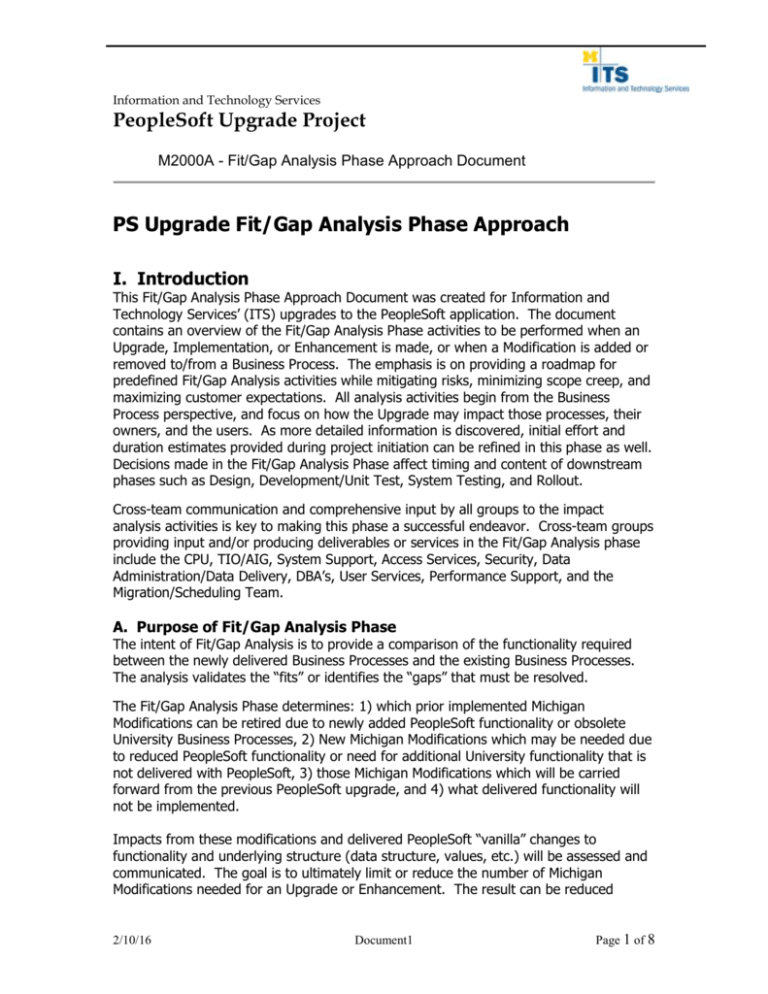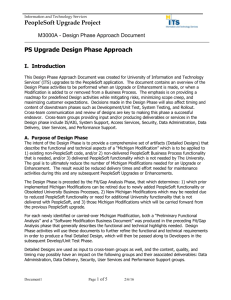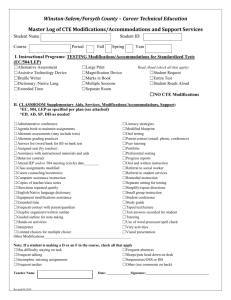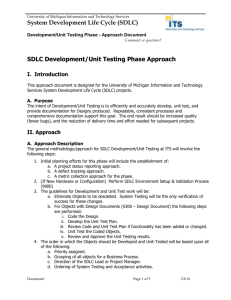PeopleSoft Upgrade Fit/Gap Analysis Phase Approach
advertisement

Information and Technology Services
PeopleSoft Upgrade Project
M2000A - Fit/Gap Analysis Phase Approach Document
PS Upgrade Fit/Gap Analysis Phase Approach
I. Introduction
This Fit/Gap Analysis Phase Approach Document was created for Information and
Technology Services’ (ITS) upgrades to the PeopleSoft application. The document
contains an overview of the Fit/Gap Analysis Phase activities to be performed when an
Upgrade, Implementation, or Enhancement is made, or when a Modification is added or
removed to/from a Business Process. The emphasis is on providing a roadmap for
predefined Fit/Gap Analysis activities while mitigating risks, minimizing scope creep, and
maximizing customer expectations. All analysis activities begin from the Business
Process perspective, and focus on how the Upgrade may impact those processes, their
owners, and the users. As more detailed information is discovered, initial effort and
duration estimates provided during project initiation can be refined in this phase as well.
Decisions made in the Fit/Gap Analysis Phase affect timing and content of downstream
phases such as Design, Development/Unit Test, System Testing, and Rollout.
Cross-team communication and comprehensive input by all groups to the impact
analysis activities is key to making this phase a successful endeavor. Cross-team groups
providing input and/or producing deliverables or services in the Fit/Gap Analysis phase
include the CPU, TIO/AIG, System Support, Access Services, Security, Data
Administration/Data Delivery, DBA’s, User Services, Performance Support, and the
Migration/Scheduling Team.
A. Purpose of Fit/Gap Analysis Phase
The intent of Fit/Gap Analysis is to provide a comparison of the functionality required
between the newly delivered Business Processes and the existing Business Processes.
The analysis validates the “fits” or identifies the “gaps” that must be resolved.
The Fit/Gap Analysis Phase determines: 1) which prior implemented Michigan
Modifications can be retired due to newly added PeopleSoft functionality or obsolete
University Business Processes, 2) New Michigan Modifications which may be needed due
to reduced PeopleSoft functionality or need for additional University functionality that is
not delivered with PeopleSoft, 3) those Michigan Modifications which will be carried
forward from the previous PeopleSoft upgrade, and 4) what delivered functionality will
not be implemented.
Impacts from these modifications and delivered PeopleSoft “vanilla” changes to
functionality and underlying structure (data structure, values, etc.) will be assessed and
communicated. The goal is to ultimately limit or reduce the number of Michigan
Modifications needed for an Upgrade or Enhancement. The result can be reduced
2/10/16
Document1
Page 1 of 8
Information and Technology Services
PeopleSoft Upgrade Project
M2000A - Fit/Gap Analysis Phase Approach Document
delivery times and effort needed for maintenance activities during this and any
subsequent PeopleSoft Upgrades or Enhancements.
“Preliminary Functional Analysis” and “Software Modification” Documents are produced
which describe the general functional and technical requirements needed. The
Preliminary Functional Analysis document serves as a functional, high-level identification,
impact analysis, and overview of new or changed functionality as delivered by
PeopleSoft, in regards to the existing System. The Software Modification Document
describes in detail what associated modification(s) need to be made in order to support
the new, changed, non-implemented or obsoleted functionality, based upon the
preliminary analysis completed earlier.
Key to maintaining consistency during and between upgrades is the continuously
updated Inventories of Interfaces, Reports, RDA’s, Batch Jobs, and Data Warehouse
tables, records, and fields. Also, Preliminary Functional Analysis Documents and
Software Modification Documents should be able to reference each other and allow easy
look-ups between Business Processes, Modifications, Objects, and Designs.
Design Phase activities will use these documents to further refine the functional and
technical requirements in order to produce a final Detailed Design, which will then be
passed along to Developers in the subsequent Development/Unit Test Phase.
II. Fit/Gap Analysis Phase Approach
A. Fit/Gap Analysis Phase Approach Description
The approach used for this upgrade, and the dependencies between activities can be
described as… {insert upgrade-specific information here}.
The general methodology/approach for the PeopleSoft Upgrade Fit/Gap Analysis Phase
at ITS is described in the following steps:
2100 Prepare/Validate Environment/Infrastructure
2110 Application Architecture Confirmation
o
Determine Impact on Application Architecture
Prepare Application Architecture Impact Statement (IS)
o
Review Application Architecture Changes
Review Application Architecture Impact Document
Review Application Architecture Impact Checklist
2120 Validate Project Environment (MICHX, YYDEMOX, YYWORKX)
o
2/10/16
Set up “DEMO” and “Sandbox” Environments (IS)
Document1
Page 2 of 8
Information and Technology Services
PeopleSoft Upgrade Project
M2000A - Fit/Gap Analysis Phase Approach Document
o
Prepare Fit/Gap Security
Review Fit/Gap Security Setup Checklist
o
Validate “DEMO” and “Sandbox” Environments
Prepare Fit/Gap Analysis Environment Validation Checklist
Review Fit/Gap Analysis Environment Validation Checklist
2130 Validate Fit/Gap Support Tools
o
Prepare Project Support Tools (IS)
o
Validate Project Support Tools
People Tools, People Books, PS Release Notes, Conference Materials, Standards
Prepare Fit/Gap Analysis Project Support Tools Checklist
Review Fit/Gap Analysis Project Support Tools Checklist
2200 Functional Fit/Gap Analysis
2210 Business Process Impact Analysis
o
Review “As-Is” and Delivered Business Process Models
o
Determine Challenged Policies
Prepare Policy Mods Challenge Document
o
Identify Vanilla Functional Changes
Prepare Preliminary Functional Analysis Document(s)
o
Identify Impacted Modules, Workflows, and Processes
Update Preliminary Functional Analysis Document
Update Upgrade Changes Database
o
Determine Business Process Impacts
For End Users, Systems, Reports, Interfaces, RDA’s, Security, Data Warehouse,
Data Structures, Batch Jobs, Queries
Update Preliminary Functional Analysis Document
Update Upgrade Changes Database
2220 Modifications Impact Analysis
o
Determine Challenged Modifications
Prepare “Modifications Summary” Document
Prepare “Policy/Mods Challenge” Document(s)
Update Upgrade Changes Database
o
Determine New Modifications, Existing Modifications Carried Forward, Obsolete
Modifications
Prepare “Modifications Summary” Document
Update Upgrade Changes Database
o
2/10/16
Define/Review Modifications
Document1
Page 3 of 8
Information and Technology Services
PeopleSoft Upgrade Project
M2000A - Fit/Gap Analysis Phase Approach Document
Prepare “Software Modification” Document(s)
Prepare “Software Modifications Documents Summary”
2230 Software Confirmation
o
Review Upgrade Features with Customer
Review “Policy/Mods Challenge” Document(s)
Review “Software Modification Document(s)”
Review “Software Modifications Documents Summary”
o
Prepare User Demo Sessions
Prepare User Scripts
Prepare User Data
o
Perform User Demo Sessions
o
Document Alternative Solutions for Fit/Gaps
Prepare “Request for Deferred/Alternate Functionality Document(s)”
2300 Technical Fit/Gap Analysis
2310 Online Objects Analysis (Views, Pages, Components, Records)
o
Generate PS Online Compares
o
Produce Compare Reports
o
Determine Impact on Objects and Records
o
Update “Software Modifications Document” (if needed)
o
Update Upgrade “Project” (if needed)
o
Update the Upgrade Changes DB
2320 Batch Objects Analysis (SQR, Cobol)
o
Generate Batch Objects Compares
o
Produce Compare Reports
o
Determine Impact on Objects and Records
o
Update Inventory of Batch Jobs
o
Update “Software Modifications Document” (if needed)
o
Update the Upgrade Changes DB
2330 Interface Objects Analysis (SQR, Cobol, App Engine)
2/10/16
o
Run Compares (App Engine)
o
Produce Reports (App Engine)
o
Determine Impact on Objects and Records
o
Update Inventory of Interfaces
o
Update “Software Modifications Document” (if needed)
o
Communicate to External Orgs.
Document1
Page 4 of 8
Information and Technology Services
PeopleSoft Upgrade Project
M2000A - Fit/Gap Analysis Phase Approach Document
o
Update the Upgrade Changes DB
2335 RDA Objects Analysis
o
Update Inventory of RDA’s
o
Determine Impact on Objects and Records
o
Update “Software Modifications Document” (if needed)
o
Communicate to External Orgs.
o
Update the Upgrade Changes DB
o
Submit M1 for each RDA to be tested or modified (if needed)
2340 Report Objects Analysis (SQR, Cobol, Crystal, Query)
o
Run Compares
o
Produce Reports
o
Determine Impact on Objects and Records
o
Update Inventory of Reports
o
Update “Software Modifications Document” (if needed)
o
Update the Upgrade Changes DB
2350 Data Warehouse Objects Analysis (Tables, Records, Fields)
o
Run Compares
o
Produce Reports
o
Determine Impact on Objects and Records
o
Update Data Warehouse Impacts Document
o
Update Inventory of Data Warehouse Tables, Records, Fields
o
Update “Software Modifications Document” (if needed)
o
Update the Upgrade Changes DB
2400 Formal Review
2410 Prepare Fit/Gap Analysis Phase Review
o
“Modifications Summary” Document
o
“Software Modification” Documents
o
“Application Architecture Impact Statement”
2420 Receive Business Process Owner & System Owner Approval
o
Update “Log of Project Deliverables”
2430 Conduct Approval Session w/Upgrade Director
o
Update “Log of Project Deliverables”
2440 Cross-Project Walkthrough (if needed)
2450 Review New Business Processes & System Functionality with Affected Groups
2460 Update Fit/Gap Analysis Phase Completion Checklist
2/10/16
Document1
Page 5 of 8
Information and Technology Services
PeopleSoft Upgrade Project
M2000A - Fit/Gap Analysis Phase Approach Document
III. Status and Reporting Metrics
A. Error Tracking Approach
During the Fit/Gap Analysis Phase, errors discovered in deliverables will be logged into
the Lotus Notes Issues or similar database. The database will provide the necessary
information for the team members and others as well as provide management with
reports. The team members need the name of the reviewer, date discovered, the
requirements, and any other relevant information. Refer to ITS Project Management
Methodology for additional information.
B. Fit/Gap Analysis Phase Tracking Approach – Metrics To Utilize
The Fit/Gap Analysis activities will be tracked by Module, then Business Process, and
within each Business Process, the Modification or Impact by Objects. Leads will be
responsible for ensuring that time is entered into Planview and all stats are reported to
the Fit/Gap Analysis Phase lead in a timely manner. There may be additional reporting
requirements, and the CPU’s may have additional detailed reports needed. Refer to ITS
Project Management Methodology for additional information.
Suggested Metrics to be tracked:
1. Number and Percentage of New, Obsolete, Carried-over, and Deferred Modifications, by
priority (A, B, C), that are in progress, in error, in review, approved, deferred, or not
begun.
2. Number and Percentage of Preliminary Functional Analysis documents, by priority (A, B,
C), that are in progress, in error, in review, approved, deferred, or not started.
3. Number and Percentage of Software Modification documents, by priority (A, B, C), that
are in progress, in error, in review, approved, deferred, or not begun.
4. Number of Eliminated or Obsolete Modifications.
5. Percentage of Effort Completed.
6. Percentage of Effort Remaining.
7. Percentage of Effort Earned/Earned Value (Planned vs. Actuals).
C. Fit/Gap Analysis Phase Status/Issues Meeting
During Fit/Gap Analysis Phase, it is recommended that a weekly status meeting be held
at the same scheduled time on the same day each week. This meeting will support a
communication process to inform the project team on Project Status, Issues, Risks, and
Changes. The Agenda can include a review of open high and medium issues, the overall
Fit/Gap Analysis Phase schedule, and any action items from the previous week.
2/10/16
Document1
Page 6 of 8
Information and Technology Services
PeopleSoft Upgrade Project
M2000A - Fit/Gap Analysis Phase Approach Document
Meeting minutes should be taken that include a list of attendees, discussion
points, and action items. Business Analysts, Leads, Reviewers, and cross-team
members should be represented in the meeting. Lessons Learned should be
identified and reviewed. Changes in Scope or Schedule should be managed as
part of the Integrated Change Control process. Refer to ITS Project
Management Methodology for additional information.
D. Acknowledgement of Deliverables
Where deliverables require an “acknowledgement”, this means that the
acknowledger has reviewed the deliverables and feels that the documentation
and/or fit/gap effort was sufficient. New, Obsolete, Carried-over, and Deferred
Modifications will require acknowledgement, as will all Preliminary Functional
Analysis and Software Modification documents. Refer to ITS Project
Management Methodology, “M110 – Log of Project Deliverables” for additional
information.
IV. Assumptions and Risks for The Fit/Gap Analysis Phase
Approach
A. Assumptions for Fit/Gap Analysis Phase Approach
The following assumptions are critical to the successful accomplishment of this Approach
to the Fit/Gap Analysis Phase for PS Upgrade:
2/10/16
Technical Environment is configured and available for use prior to beginning
Functional & Technical Analysis Fit/Gap Phase activities.
Architectural Impacts are known and reviewed prior to beginning Functional &
Technical Fit/Gap Analysis Phase activities.
New, Obsolete, or Carried-Forward Software Modification and Preliminary Functional
Analysis documents will be developed for each Modification proposed.
Compare Reports will be produced in a timely manner for objects needed.
Methodology templates & processes exist, and Team Members, Reviewers, & Leads
are trained in their use prior to initiating Fit/Gap Analysis Phase.
Realistic levels of availability and commitment are obtained for all resources involved
in Fit/Gap Analysis Phase activities.
Reviewers have availability and commitment to review, respond, and approve
deliverables in a timely manner.
Document1
Page 7 of 8
Information and Technology Services
PeopleSoft Upgrade Project
M2000A - Fit/Gap Analysis Phase Approach Document
End-User and Business Owner buy-in to proposed changes and modifications.
B. Risks for Fit/Gap Analysis Phase Approach
Technical environment not ready.
Architectural impacts not known and planned for.
Team members not trained in use of Methodology.
Inadequate commitment and/or allocation of team members’ effort.
Insufficient or not agreed-upon Scope definition.
Different levels of PeopleSoft versions implemented.
Changes to Vanilla underlying PeopleSoft structure (data, values), and their impact, will
not be discovered initially.
Impacts between teams and/or users due to Modifications or changes proposed will not
be communicated and tracked effectively.
Inventories of existing online objects, reports, batch jobs not current and up-to-date.
Compare reports unavailable when needed.
Insufficient End-User and Business Owner buy-in to proposed changes and modifications.
Inadequate level of Management commitment and follow-up to proposed Policy or
Business Process changes.
V. Deliverables
Refer to ITS Project Management Methodology, specifically “M110 – Log of Project
Deliverables” for additional information.
2/10/16
Document1
Page 8 of 8



